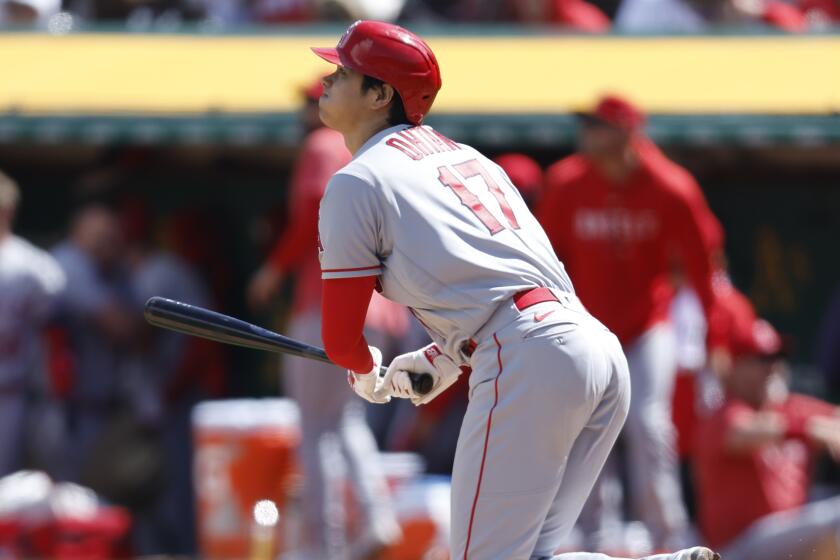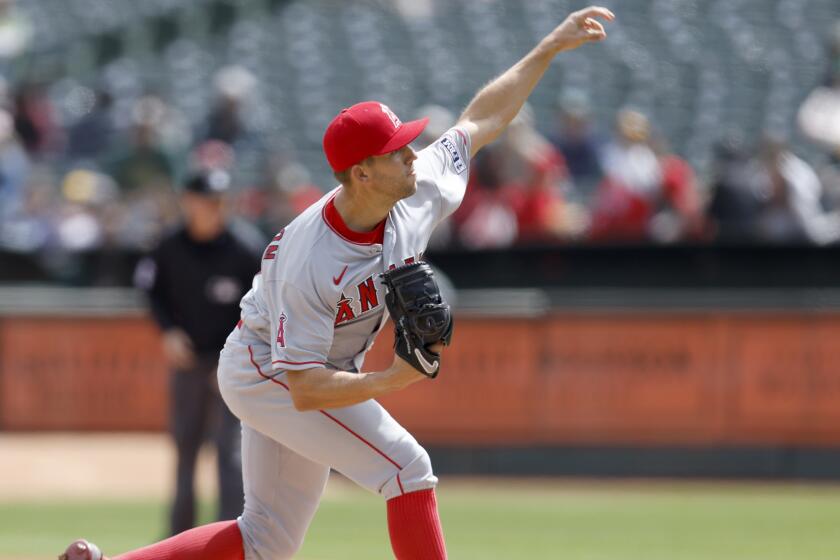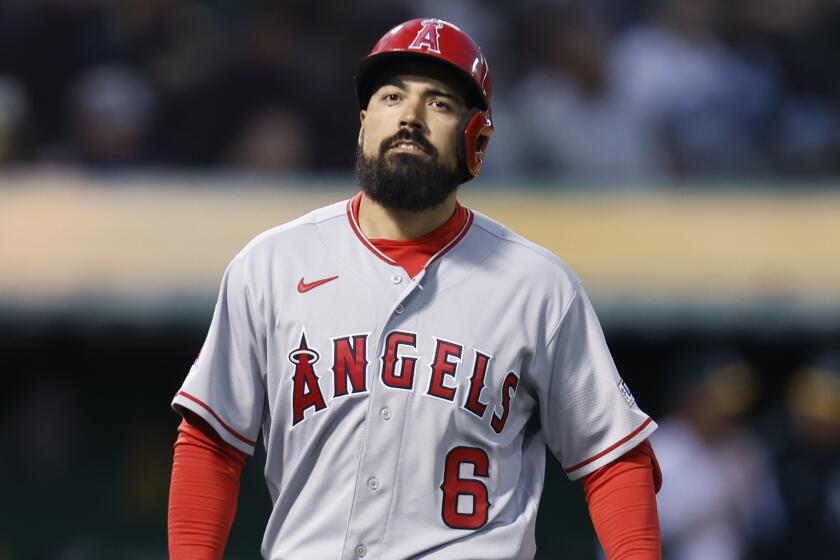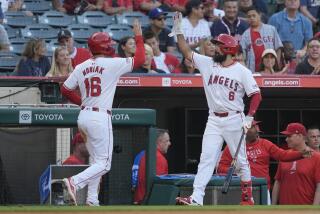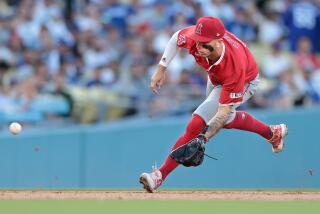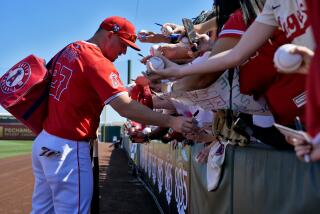Next Angels star in the making? Logan O’Hoppe striving to excel as a rookie catcher
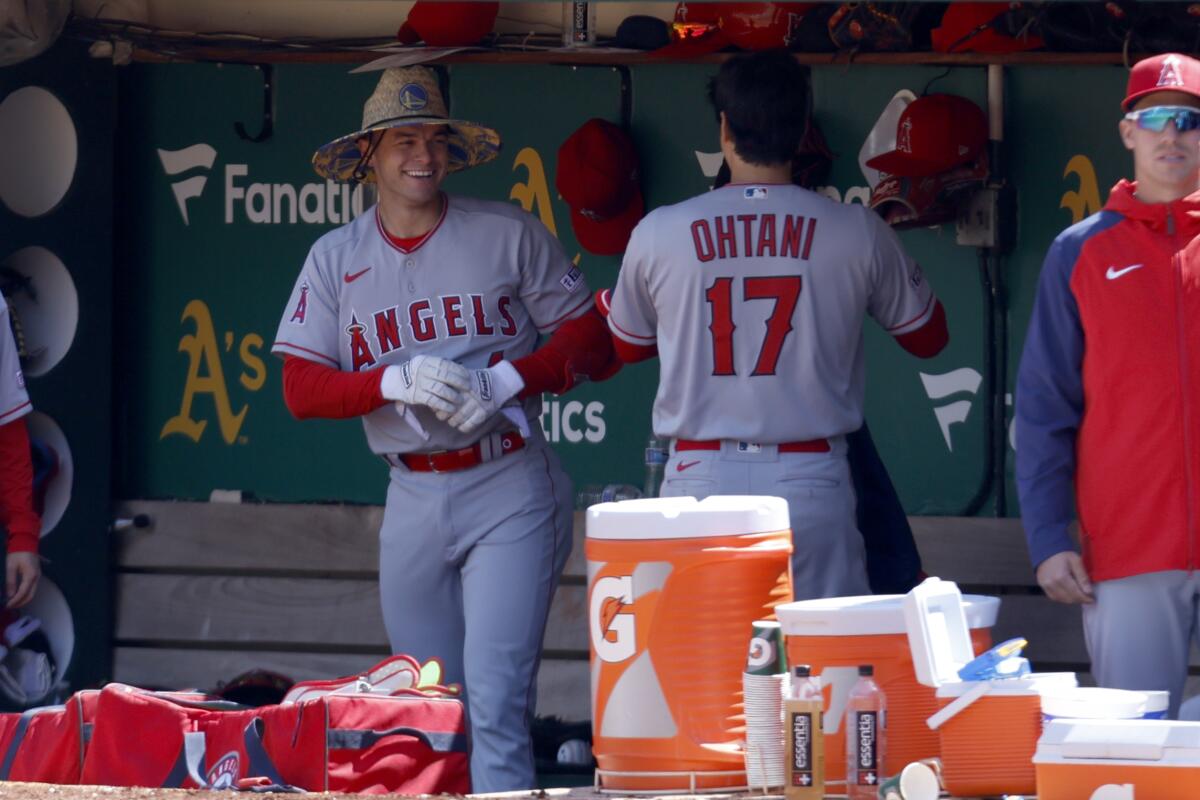
The month he spent in the big leagues the previous September did little to quell the sense of inadequacy when Chris Iannetta opened the 2007 season as the starting catcher for the Colorado Rockies just days before his 24th birthday.
“I was always overwhelmed as a rookie,” said Iannetta, whose 14-year big-league career included four seasons with the Angels from 2012-15. “You always fly by the seat of your pants in the beginning.
“You’re trying to fit in with a new group of guys at a level of the game you’ve never played at. You’re doing a lot of things that are completely foreign, even though it’s the same thing you’ve done your whole life.”
Rookie catcher Logan O’Hoppe hits a three-run home run, and Shohei Ohtani and Mike Trout also homer in a 6-0 win over the Oakland Athletics.
Max Stassi, in his fifth season with the Angels, recalls those head-spinning days as a young catcher, when he struggled to carve out a role with the Houston Astros from 2013-17, when he made just 18 big-league starts behind the plate.
“The game is crazy fast when you get here — there’s so many different things going on,” said Stassi, who is on the injured list because of a left-hip strain, during spring training. “It’s the hardest thing I’ve had to do in my career, the transition to the major leagues.”
Into this fray stepped Logan O’Hoppe, the strapping 23-year-old rookie who became the youngest Angels catcher to start on opening day on March 30 and is expected to play a significant role behind the plate this season.
The 6-foot-2, 215-pound O’Hoppe, immediately tabbed the Angels’ top prospect after he was acquired from Philadelphia for outfielder Brandon Marsh in August, had played only six professional games above the double-A level before last September.
But if O’Hoppe doesn’t struggle too much at the plate or behind it, he will spend much of 2023 in Anaheim sharing catching duties with Stassi, a fairly substantial ask for a rookie whose major league resume consisted of five games before this season.
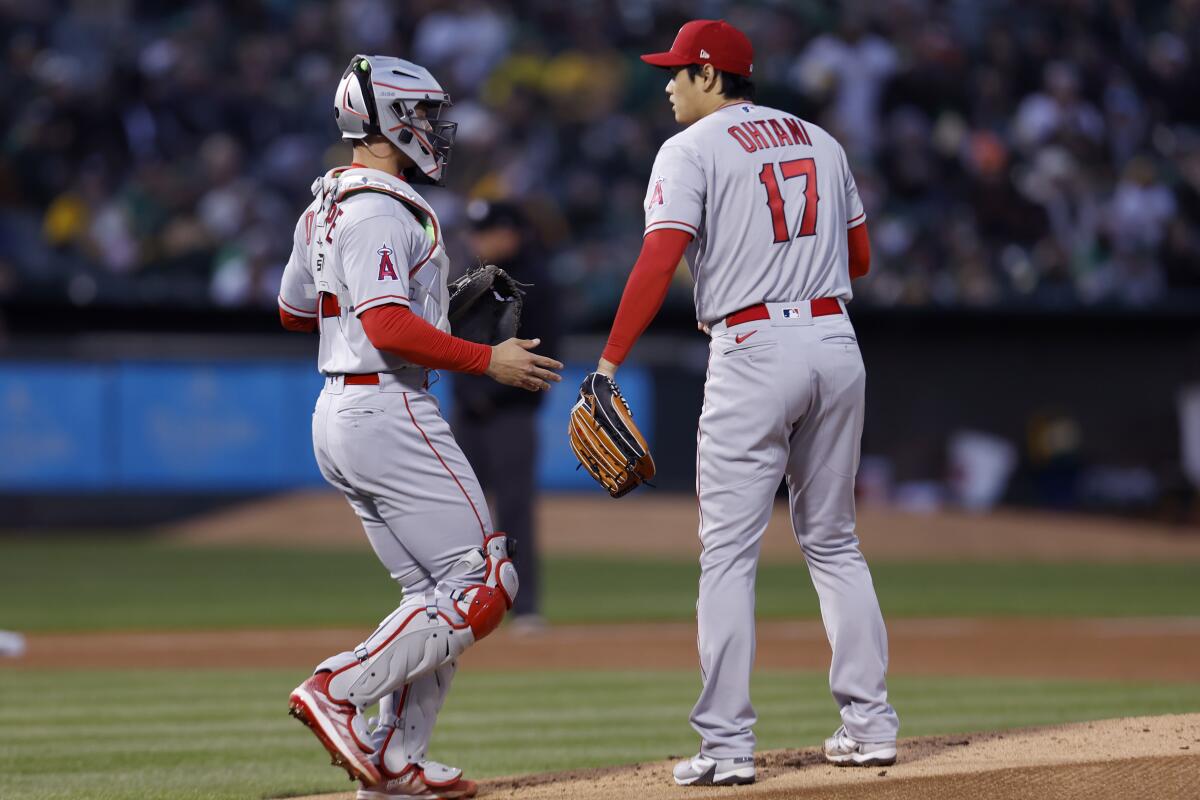
“Catcher is the toughest position to break into the big leagues at, especially on a team that is expected to win,” Angels general manager Perry Minasian said. “There’s so much decision-making, you have to be dependable, reliable, limit mistakes and learn from them. You have to develop the trust of your pitchers. For me, it’s the most important position on a club.”
The jump to the big leagues can be difficult for any player. There are plenty of established major leaguers — Mike Moustakas, Ervin Santana and Cliff Lee come to mind — who were demoted to triple-A after their first call-up before establishing a footprint in the big leagues.
Yet it is most daunting for catchers, who must master the repertoires of every starter and reliever while learning what motivates each one, process reams of statistical and analytical information and incorporate it all into pitch-calling, handle the physical rigors of the position — foul tips off body parts and the face mask, blocking pitches in the dirt, throwing to bases, framing pitches. It would be great if one could also contribute offensively while facing big-league pitching for the first extended period of time.
“I feel like the best approach is to shut my mouth and open my ears because I know my role here...”
— Logan O’Hoppe, Angels catcher
“I think the biggest challenge is keeping my mind clear,” O’Hoppe said. “There’s a bunch of stuff going on during the game, especially with the new [pitch-clock] rules, and another game with stuff off the field, too. So I’m trying to stick to what got me here and stick to those consistent thoughts because I believe consistent thoughts lead to consistent actions.”
So far, so good, for the most part. O’Hoppe has caught seven of the Angels’ nine games and is batting .240 with three homers, including a solo shot in Sunday’s 12-11, 10-inning loss to the Toronto Blue Jays, a double and nine RBIs, tying him with Mike Trout for the team lead. But opponents have been successful on eight of nine stolen-base attempts against O’Hoppe.
“I’m getting used to the environment, getting used to the third deck, all that stuff,” O’Hoppe said last week. “I’m really excited because I feel like my heart rate is a little slower than it was on opening day and last year, too.”
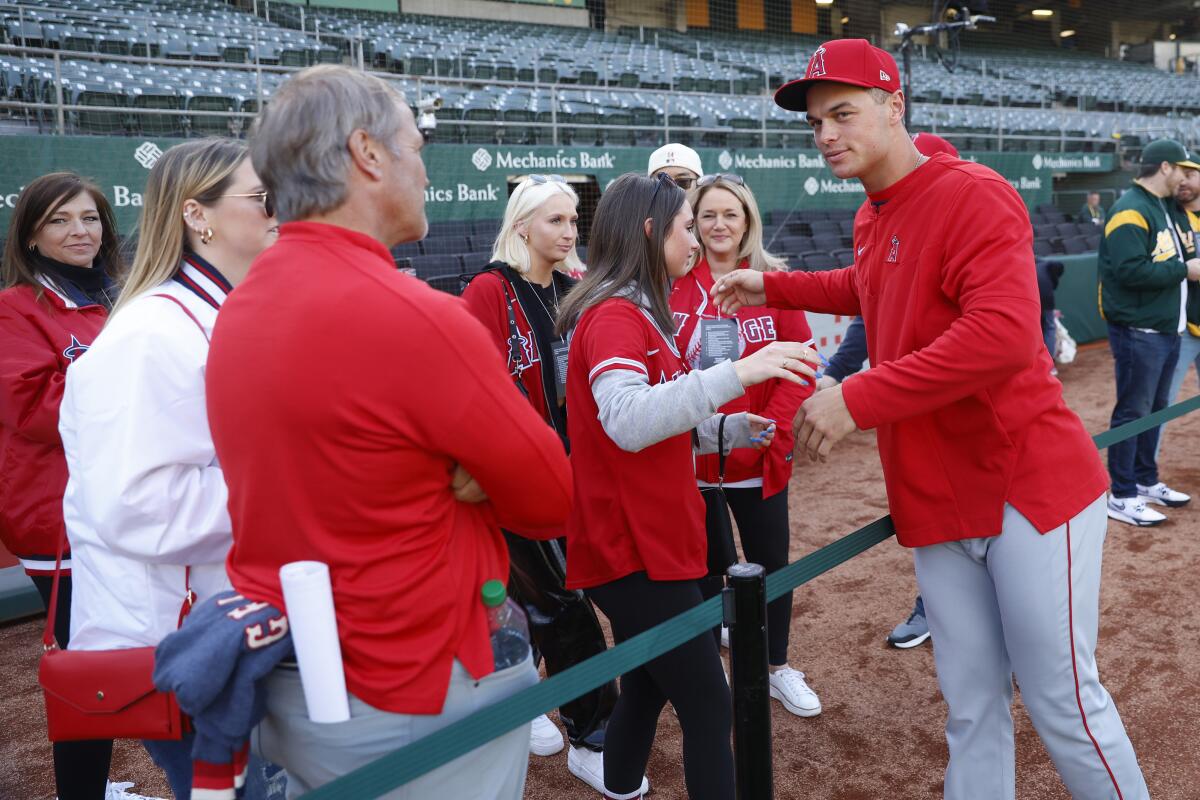
O’Hoppe’s learning curve will extend deep into the season. The first phase was a crash course in spring training, which began with the Angels stressing that defense be O’Hoppe’s top priority and offense secondary.
There was the physical work of catching bullpen sessions and handling pitchers in exhibition games, but just as important was the mental work of establishing a rapport with pitchers, learning their personalities and what makes them tick.
O’Hoppe made a point of going out to dinner with some pitchers and sitting down for breakfast or lunch with others in the dining room of the team’s spring-training complex.
“I feel like the best approach is to shut my mouth and open my ears because I know my role here — I’m the young guy, I’m not coming in spreading ideas or philosophies on anybody, not that I even have them to begin with,” O’Hoppe said.
“The hardest thing you have to deal with as a young catcher is managing your emotions throughout the course of a game.”
— Chris Iannetta, former major league catcher
“I’m just trying to soak up as much as I can and learn personalities and how to approach different situations. That’s the part of catching I love the most, getting to know different people and to learn from guys. I’m trying to be a sponge.”
O’Hoppe, a 23rd-round pick of the Phillies in 2018, spent five years in the minor leagues handling dozens of pitchers, but doing so with big leaguers who are older — and, in some cases, much older — “brings a new wrinkle to the equation,” Iannetta said. That’s why the former catcher said it’s so important to build relationships with pitchers off the field.
“You want to be able to put players in different buckets based on their personality,” Iannetta said. “Who are the fiery guys? Who needs to get kicked in the butt? Who needs to be coddled? Who needs to be encouraged? Who needs to be challenged?
“And then putting pitchers into those buckets so that when you go out there to talk to them on the mound, on the bench, in the clubhouse, you’ll know, do I need to challenge this dude, or do I need to kick him in the butt?”
Beginning in two weeks, the Angels will play 49 games in 52 days, with several matchups against the best teams in the American League.
While defense is always the priority, a young catcher probably won’t stick in the big leagues if he is an automatic out at the plate. Iannetta hit .158 with three RBIs and 18 strikeouts in his first 14 games in 2007 and began losing playing time to veteran Yorvit Torrealba.
Iannetta was demoted to triple-A Colorado Springs for three weeks in August. He returned later that month and was on the roster for Colorado’s 2007 run to the World Series but did not appear in any playoff games.
“The hardest thing you have to deal with as a young catcher is managing your emotions throughout the course of a game,” Iannetta said. “You can’t let your defense carry over to your offense and your offense to carry into your defense.”
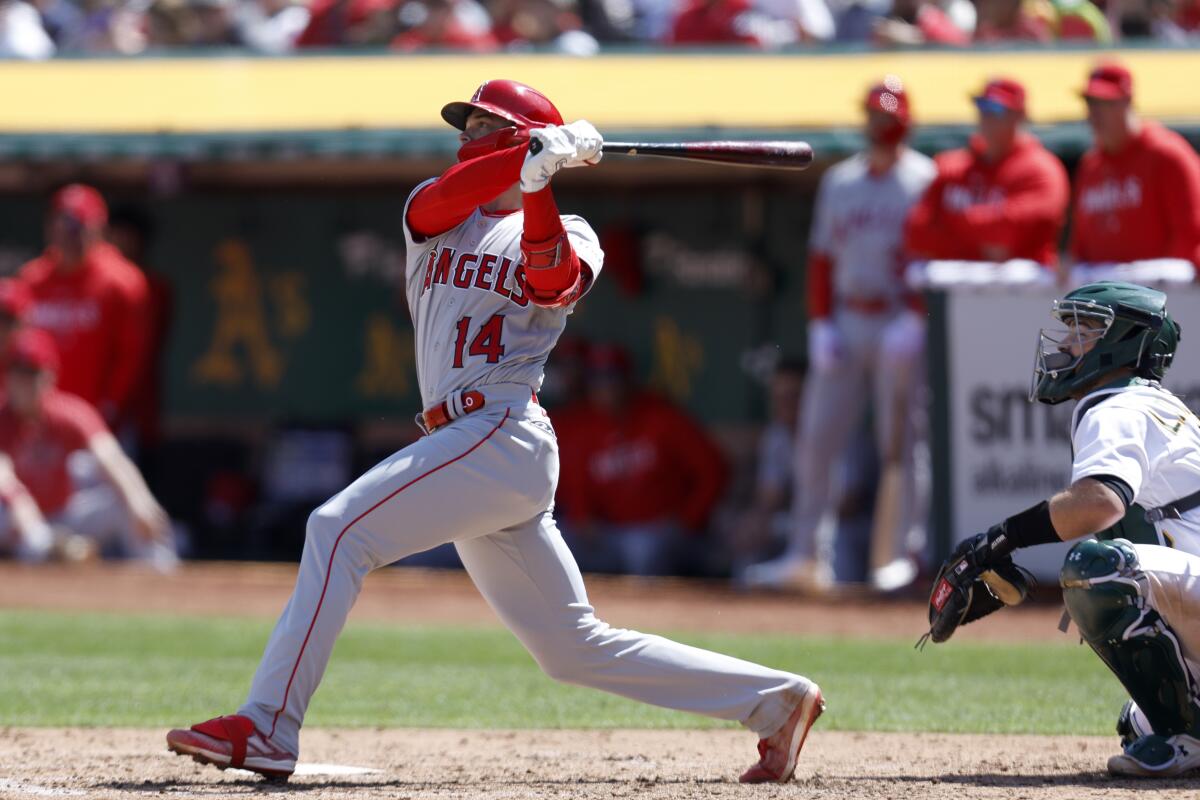
O’Hoppe’s bat helped fuel his ascent as a prospect — he hit .276 with an .850 on-base-plus-slugging percentage, 50 homers and 183 RBIs in 287 minor league games — so he has done a good job of balancing offense and defense to this point.
“I feel like when I get up to the plate,” O’Hoppe said, “it’s kind of my escape from everything else.”
That could grow more challenging as the season wears on.
“Major league pitching is a little different than the minor leagues, and so is the intensity of the games,” Stassi said. “You spend a lot more time going over scouting reports, and the games are more intense, so mentally, you’re a little more fried.”
By getting into an altercation with a fan, Anthony Rendon is proving to be a selfish millionaire who is not helping the Angels on and off the field.
The Angels believe O’Hoppe is up to the task, which is why they’re entrusting him with such an important role on a team that must snap its eight-year playoff drought to have any chance of retaining Ohtani, the two-way star who will be a free agent next winter.
Several rookie catchers have played key roles for World Series clubs — Buster Posey for the San Francisco Giants in 2010, Yadier Molina for the St. Louis Cardinals in 2004, Will Smith for the Dodgers in 2020, William Contreras for the Atlanta Braves in 2021. The Angels hope to add O’Hoppe to that list.
“He checks a lot of boxes from a physical standpoint, on the offensive and defensive ends, and on the mental side for work ethic and leadership,” Minasian said. “He’s going to go through some ups and downs, but we feel really good about his ability to handle the moment. He’s a very mature young man who’s built the right way. You can just tell.”
More to Read
Go beyond the scoreboard
Get the latest on L.A.'s teams in the daily Sports Report newsletter.
You may occasionally receive promotional content from the Los Angeles Times.

